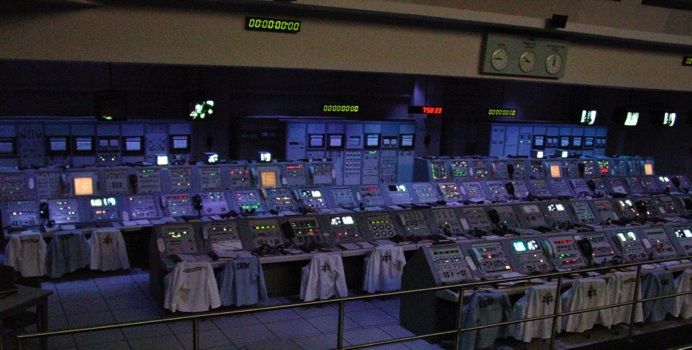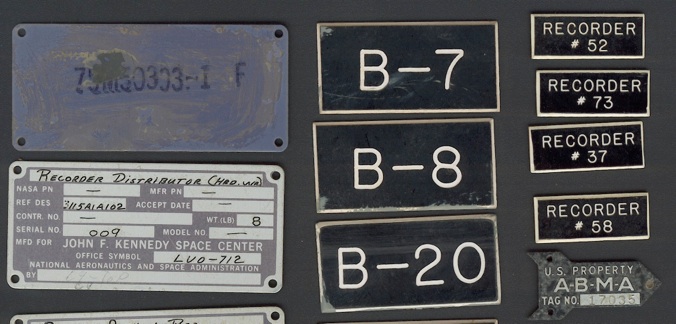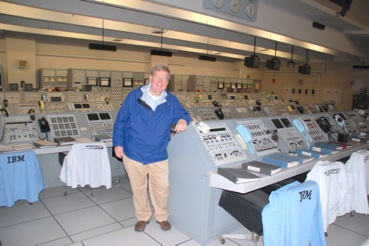Apollo 8 Firing Room Exhibit, Apollo/Saturn V Center, Kennedy Space Center

By far the largest and most impressive collection of Apollo/Saturn Firing Room panels can be seen in the Apollo/Saturn V Center, which is a stop on all of the public bus tours of Kennedy Space Center (official site: Apollo/Saturn V Center). After arriving at the Center, visitors watch a brief presentation which describes world events in 1968 and sets the context for Apollo 8.
Visitors are then ushered into a viewing area which overlooks “the actual Firing Room 1 as it was during the launch of Apollo 8.” A highly effective and powerful presentation follows, in which the panels light up and the TV monitors and sound system follow the countdown and liftoff of Apollo 8.
I had the opportunity to go “behind the scenes” in the Firing Room 1 exhibit on February 10, 2010, two days after witnessing the launch of STS-130. I photographed every piece of equipment on the floor of the exhibit.
Also available are edited versions of the photos, perspective-corrected and cropped to each panel.
What led me to this conclusion:
-
•First, there are a number of S-IB consoles in the exhibit. Firing Room 1 was never used for Saturn IB launches.
-
•Second, an obvious discrepancy is that much of the intercom equipment (example at top right) is not what was used in the Operational Intercom System (OIS) in the LCC Firing Rooms (bottom right). Rather, it is what was used in Blockhouses 34 and 37B. The same is true of the chart recorders at the back of the room; they were almost certainly from the CCAFS blockhouses.

If they weren’t from Firing Room 1, where did these panels come from?
About a year after my visit, I spoke a gentleman who worked for the company which built the exhibits for the Apollo/Saturn V Center. He was one of the people tasked with picking up the equipment that would be placed in the exhibit and shipping it off to be cleaned and prepared. He said that the most of the control panels and consoles were in a concrete block building in the Industrial Area of KSC. They were in a room with terraced flooring, adjacent to a “room with black walls that held a full-sized Lunar Module.” This matches the description of the Flight Crew Training Building (FTCB). [The FTCB originally held the simulators that the Apollo astronauts used for training. After the end of Apollo, the simulators were removed. In 1976, the FTCB was turned into a visitors center which held LM-9 and a Firing Room exhibit. LM-9 also ended up at the Apollo/Saturn V Center.] For the chart recorders and a few additional pieces of equipment, the gentleman was directed to the VAB. He remembered taking an elevator up into an area of the VAB and retrieving the equipment from a storage area. He was told to remove the tags from the equipment before sending it off to California for construction of the exhibit. He saved a few tags, some of which are shown in the photo below.
The ABMA tag clearly pre-dates Apollo; the Army Ballistic Missile Agency was folded into NASA in 1960. Locator tags of the style of the B-7, B-8, and B-20 tags in this photo were not used in the LCC. However, they match well with photos from the LC-34 and LC-37B blockhouses. A similar tag is seen in the center of the photo at right, which is from the LC-34 Blockhouse Firing Room. Likewise, the “Recorder #” designation was not used in the LCC Firing Rooms during Apollo.
As mentioned above, the Propulsion System Preparation and Control panel in this exhibit almost certainly came from LC-37B, since it supported the early version of the S-IV stage, which was only launched from LC-37B.

Apollo 8 Firing Room 1 Exhibit
Apollo/Saturn V Center
KSC


Intercom panels seen throughout the Apollo/Saturn V Center exhibit
OIS Intercom panel from Firing Room 1, 1966
-
•Detailed examination of the photos of the panels in the Apollo/Saturn V Center show that a preponderance of them are S-IB and S-IVB related.
-
•Many of them appear to be early versions of panels, later variants of which were known to be used in the Skylab manned launches and the ASTP mission.
-
•A telltale sign of the origin of the “RP-1 Control” panel in the Apollo/Saturn V Center is that one of the indicator lights is labeled “Blockhouse,” a term which was not used for the LCC.
-
•A “Propulsion System Preparation and Control” panel in the Apollo/Saturn V Center has switch positions for six engines; the S-IV stage of the early unmanned Saturn launches was the only Saturn stage with six engines. These versions of the Saturn I were launched from LC-37B.
There are about one hundred control panels in the Apollo/Saturn V Center exhibit, but I can only identify seven with certainty as being used for Saturn V launches:
-
•S-IC Sequence panel
-
•Five S-II panels (S-II Networks, Events Display, S-II Propellant Monitor, S-II Ground Pneumatics, and LH2 Components)
-
•An “OWS Refrigeration” panel, which monitored the refrigerators for food and perishables on Skylab before it was launched.

Of these panels, only the “LH2 Components” panel appears to be a possible match with one in the 1966 Firing Room 1 reference photos.
The evidence of a match is tenuous at best: eight screw heads in the face of the panel are turned to approximately the same orientations in the Apollo/Saturn V Center panel as they are in the 1966 reference photo.
The composite at right shows the same portions of the two panels. The left half is from the panel photographed in the Apollo/Saturn V Center; the right half is from the 1966 reference photos of Firing Room 1. Note that there have been modifications to the panel (most obvious are the two-position switches added between the three-position switches at top and bottom, and the removal of labels and lettering), but the screw heads marked with arrows appear to be in matching random orientations - highly unlikely to be just a coincidence.
Intuitively, I knew that this could not be the complete Firing Room 1, inasmuch as there were only four rows of consoles in the exhibit (there were nine rows of consoles in the Apollo Firing Rooms). However, what most surprised me in examining my photos was that while all of the equipment is unmistakably genuine, perhaps only one panel is actually from the Apollo-era Firing Room 1, and much of the equipment is not even from the LCC.
(c) 2012 Jonathan H. Ward
